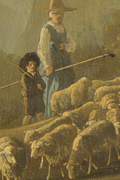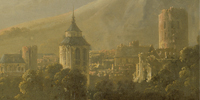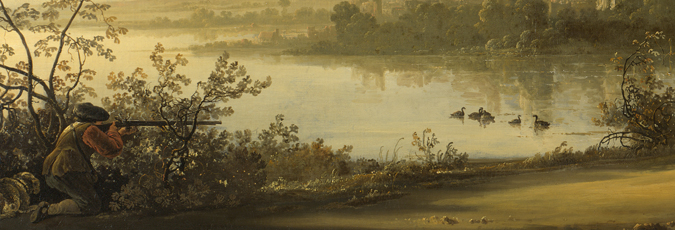Pupils from Halstow Primary School, London changed from reluctant writers to expert storytellers, inspired by 'River Landscape with Horseman and Peasants' by Aelbert Cuyp and 'Perseus turning Phineas and his Followers to Stone' by Luca Giordano.
Watch a pupil's storytelling performance and find out how this project has revolutionised teaching practice.
Inspired by 'River Landscape'
Transcript
A pupil from Halstow Primary School tells an original story, inspired by 'River Landscape with Horseman and Peasants', as part of the Out of Art into Storytelling project.
Halstow Primary School pupil:
Once, long, long ago, back in the mists of time, Atticus lived in a little town called Ato with his lovely tardy wife called Ephineas[?]. However, there was a very mean man called Claude, and he over-taxed the poor, leaving them with no money and no clothes.
This problem didn't last very long, though, because Claude was already planning something else. He had two potions lying in the middle of his house. One to change him into anyone he liked for 10 to 30 minutes, for however long he liked. He could even change into that person for one hour if he wanted to.
Claude had four... but he wanted to love Ephineas for very long, so he went away to [unclear]. And so he bought the second potion after having trouble with the first potion.
Claude, cleverly disguised as Atticus, asked Ephineas if she would like a cup of tea. Ephineas said yes, very happily, and so Claude went away to make tea just like the way Atticus did, and dropped the second potion in it.
And then something very strange happened. Ephineas started running after Claude, and whooshed after him as quick as lightning.
Atticus hadn't been here before, so when he saw Ephineas run past, he asked what was up with her, and what did Ephineas reply? She replied that he was a stranger and he shouldn't be getting in her way and told him to get out of the way immediately.
Atticus was horrified when he saw Ephineas embrace the mean Claude, and the wedding ring slipped off, down into the gutter. Atticus wondered what had happened. What had happened in the whole wide world?
And then he went to Claude's house and saw these bubbling potions, not full, but empty. It happened to be a very bad thing, and Atticus had to mount his very old horse [unclear] and went all over the mountains, down into the river and into the caves and got dripped on all over by stalactites.
But finally he found out from an old man with a long white beard that reached all the way to Greenwich Park, that the three-headed leopards... There were seven of them, so there were 21 heads and 21 pairs of white fangs. And in the middle was the Philosopher’s Flower, a brightly-coloured flower in the colours of the rainbow and that could take away any potion or spellbound person.
Tom Gray, team leader, Year 3 and 4:
"I was soon to find out that this project would fundamentally change my teaching practice and have an incredible effect on the achievements of children, not only within my class, but across the Year 3 and 4 team and beyond."
Zombies not welcome

"Instead of a retelling, I decided the children should create their own class story. This filled me with dread due to the previous memories of stories created by different children in different classes, usually featuring aliens or zombies or, more likely, alien zombies!"
"To my amazement, no aliens or zombies appeared in their stories and they were superb pieces of writing. This, I feel, was due to the fact that we had spent much time discussing the painting, dramatising the scene and its various narrative possibilities and basically bringing the painting to life."
Expert storytellers
"Spending time talking about and analysing the painting, playing vocal story games and story mapping had an amazing impact on the children's writing. The stories were like never before. It was an amazing day and I enjoyed marking every book!"
"The stories flowed and I sensed a realisation from some of my reluctant writers that they could, indeed, be expert storytellers."
Retelling in restaurants
"When parents come and tell you that their children have caused other adults to make incredibly positive comments about them because they are hearing them retelling these stories in restaurants and on trains, then the only outcome can be a winning one!"
"I will never teach a narrative unit again without storytelling and story mapping being key ingredients within the process."


